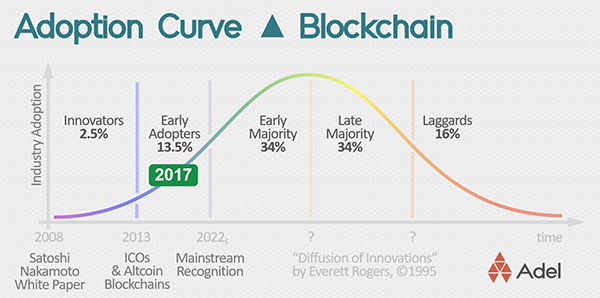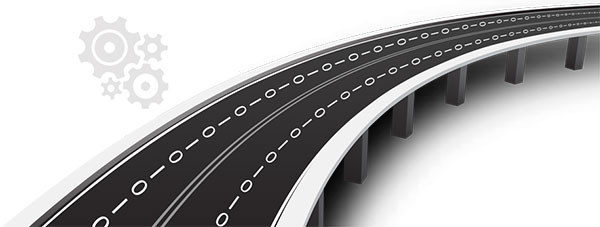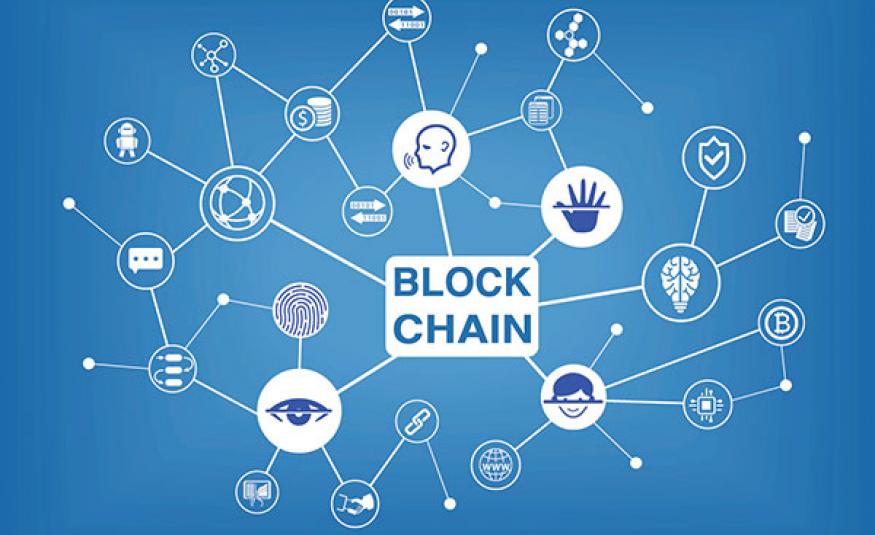Enrico Gallorini, CEO, GRS Research & Strategy, discusses Blockchain and its key role within the global exhibition industry.
During the recent UFI European Conference in Verona, 2- 4 May 2018, the Digital Disruption Section introduced, for the first time, the theme of the Blockchain in the exhibition industry. In order to have a clearer introduction about this important theme, we interviewed Enrico Gallorini (CEO – GRS www.grsnet.it), who will be speaking at the “Educational Forum on Digital Innovation” in Hannover, 11 June 2018.
Blockchain in the collective imagination it is a dark technology, linked to the world of cryptocurrencies and wild speculations. But according with experts and leaders all over the world, in reality, blockchain has many other applications.
“If you say Blockchain, people think just about bitcoin,” says Enrico Gallorini, who adds “but nothing could be more wrong… or better: nothing more incomplete. The terms Blockchain and cryptocurrency are in fact linked to each other, but they are conceptually very different entities. In order to start with clear examples, we can say that Blockchain is the Operations system, like IOS for the Iphone, and that bitcoin is just the first “App”.
In fact bitcoin (as well as other cryptocurrencies) is a value of exchange based on the protocol of the Blockchain.
This new technology is in continuous and constant evolution: and the Blockchain architecture promises applications in many fields, from politics to health, through cloud computing and the secure management of digital identities, and also the exhibition industry.
First of all, what it is Blockchain?
Blockchain is a new unexpected technology. As for the electricity, the rail transportation, the internet itself, we will need time to see and to discover its applications.
However, now that it exists, it will stay; and for the exhibition community it is a very interesting innovation.
Our industry is based on enabling supply chain business, networking and human relations, and this new paradigm will change how people will do business, network and personally interact in the future.
Starting from the basics, we have to remember that we live in the digital era. People born after 2000 are called 'Digital Native'. The basic element of this period is that “Digital Data” is essentially fundamental for almost all the activities.
If we consider internet as the “Data Transportation Highway” than Blockchain represents the secure data transportation system, fitting the trust on gap between internet users.
Experts say that Blockchain is the new internet. In fact, for the first time, an internet user is now able to transfer a unique piece of digital property to another internet user, such that the transfer is guaranteed to be safe and secure, everyone knows that the transfer has taken place, and nobody can change the legitimacy of the transfer… and all the information are encrypted so that the owner can decide at whom let the information known.
The consequences of this innovation are hard to overstate, in any industry, but the world is going to be for sure different.


The term comes from the concept of a chain of blocks, correct? And how does Blockchain work?
Blockchain is also known as a particular type of DLT or Distributed Ledger Technology, which is an open register of shared, decentralised and distributed information. From a practical point of view, it is a database which, instead of being on a single server, is structured in blocks distributed on different places and called “nodes of a network”.
The strength of the Blockchain is in this concept: the information entered in the database is replicated in real time in all the nodes of the network, and the nodes themselves can at any time verify the validity of the information entered.
So the fundamental point is that there is not a single information centre: the data - or more precisely the blocks - are simultaneously in the possession of all the subjects that are part of the Blockchain network.
In addition to the capability to verify information in an undisputed way, such data, once written and validated, cannot be changed anymore. In the Blockchain it is only possible to add information, and not to alter those that have already been stored. This feature guarantees maximum transparency of information in the database.
How does this validation system work?
In Blockchain there are some nodes of the system, the so-called “miners”, which are users authorised to observe, take note and confirm the inclusion of new blocks in the Blockchain.
In order to explain better, let’s make a concrete example: “let’s suppose, that our Blockchain is a register of real estate trades and that Paul wants to sell a property to Ann. In this case, the information to be entered in the database are all those related to this transaction, such as the data of the property, its value, the availability of Ann, the actual property of Paul, etc.
All this information, appropriately coded, is inserted in a new block that is then prepared to be subjected to the validation of the network. The most important mechanism of the Blockchain is that we add the last piece of the previous block (and this is way it is called “chain”, each block is linked to the previous one) and the so-called “nonce”, that is a random number coming from the Cryptology system called Hash function, which makes this block unique and encrypted. At this point, the miners are ready to validate the deal, or to solve Hash puzzle of the block.
This is possible by trial and error, for very big numbers of time, using computing power.
The miners computers perform interactively a series of mathematical operations with the data present in the block, until a certain output value is obtained. When a miner solves a block, it is finally added to the chain, all the other nodes verify the correct Hash Puzzle, and then the transaction is considered valid, completed and stored on all the nodes of the Blockchain.
At that time, the information "Paul sold a property to Ann" is published, accessible to all participants and unchangeable over time.
In order to clarify this miners game, we can use the “Bingo Game” example, because it is quite similar. The mining process can be considered as a game of chance “like Bingo”, in which each player matches numbers printed in different cards with the numbers the game host at random, marking the selected numbers with tiles.
Obviously because it is random, anyone can win, but in order to have more possibility, the player can buy more cards…that, in Blockchain, is the computing power.
Like in the Bingo game, when a player finds the selected numbers they call out "Bingo!" to alert all participants (other miners) to a winning card, which prompts to examine the card for verification of the win. Players compete against each other to be the first to have a winning arrangement for the prize or jackpot.
In the Blockchain of bitcoin the jackpot are 12,5 new bitcoins for the first miner that solves the Hash puzzle, which at the actual rate of $10,000 per bitcoins means $125,000.
The Blockchain of bitcoin creates a new block every 10 minutes.

Talk a bit more about Bitcoin and link to Blockchain...
As explained before: the Blockchain is totally linked with bitcoin. Most of the applications are actually in the financial sector, in particular in the cryptocurrency and fintech.
The creator of bitcoin, Satoshi Nakamoto (that is still unknown), in his bitcoin whitepaper, explained very well the main idea, which was to create a new form of currency.
Personally, I invite everyone to reed the white paper of Nakamoto (https://bitcoin.org/bitcoin.pdf). Click here to read the white paper.
For its characteristics, the protocol of the Blockchain is particularly indicated to make secure and transparent payments and financial transactions. And as we explained, the peculiarities of bitcoin-like cryptocurrencies lie in the fact that miners are rewarded with a certain amount of currency as well as with a variable commission, linked to the entity of the transaction - whenever they resolve a block.
What are the other uses of Blockchain?
In addition to finance, the Blockchain ecosystem also includes much more. One important example is politics. On March 7 2018, for the first time in the world, the Blockchain was used to manage (partially) the political elections of Sierra Leone.
In particular, electors' votes were stored in the “Agora” system: a Blockchain set to record the votes completely anonymously, but publicly available, both to political parties and to third party control bodies, for verification, recount and validation.
In this case the goal was to reduce the costs of elections, saving on infrastructure, and to minimise corruption.
Taking into account that, according to various estimates, within half a century most countries will adopt some form of digital voting, because the Blockchain is the only technology that can provide a completely transparent and verifiable electoral system.
So it seems there are many other uses?
Yes, also science and health, according to the experts' forecasts, will be interested in full by the Blockchain cyclone. The magazine “Nature” recently wrote about a system based on Blockchain to allow patients and doctors to memorise and share their health data, in this case the results of mammograms.
That information collected in sufficient quantities will serve to train artificial intelligences to recognise the presence of cancer before and better than a doctor would.
In this case, the adoption of the Blockchain ensures that the precious health data is not in the hands of any centralised body. Thanks to this technology, the information will not be in the head of a company.
Have you ever thought that Google and Facebook own millions of data on which users have no control over, and after the Cambridge Analytica scandal, it seems clear [to some] that the actual internet is “broken”.
In the world of medicine, at this moment there is no Facebook and the future use of Blockchain will preserve and secure health information in a decentralised way that will be a transparent model for managing this data (obviously encrypted.)

Anything else?
So much and the most has yet to come… We have to remember that this technology is very very new.
And to consider that it is like being in the 1994 and talking about Internet; there was no idea of what it was, there were no standards, and no clear ideas of its implication in our lives. In that period we couldn’t imagine that in the future it was possible to get in touch with friends, sharing information, photos or video in real time, buying almost everything by the phone, it would not have been believed… In that period company like Amazon, Google, Alibaba or Facebook were not even imagined from their founders…
In general, Blockchain technology is suitable for use in all scenarios that require the existence of an intermediary. This is where exhibitions have to care about, this huge change has just started and the role of the exhibition is to enable the business and create direct bridges between the supply and demand, so there are very interesting new ideas to bring in our sectors.
It seems that Blockchain is a hacker-proof system?
Cyber Security is one of the hot topic of the moment. In the Hacker community there is this expression: “there are just two sort of companies, the one that have been hacked, and the one that are not already aware that has been hacked”... experts says that on the topic of Blockchain is a system that is not unhinged from the outside.
From a technical point of view, it's not exactly like that. No one, individually, can act or modify the blocks of the chain, as, as we have seen, these are decentralised on all nodes of the network. But there is still the possibility, however remote, that one or more users, by putting together their computing power, can reach 51% of the computational capacity of the entire Blockchain network.
In this case, it would theoretically be possible to modify transaction information as desired: having control over the majority of the Blockchain network, these users could in fact act on the information and approve or discard the blocks as convenient. This scenario is however very remote, since the required computing power is extremely high and expensive and the developers are already running for cover to prepare possible countermoves to attacks of this type.
In order to close this interview, do you know how the other niches are moving in this field?
This is a very central point. In this moment for the first time in the history a lot of companies and entities have understood that this new technology is very disruptive, from any point of view. So it is quite impossible that one company alone would manage this new paradigm, for this reason a lot of industries (especially in Bank systems, Healthcare, Real Estate) are creating consortium, foundation or cooperate together.
A very interesting example is r3 (click: https://www.r3.com/)
And I think our industry should seriously think to build an intellectual panel of different companies talking about this topic in depth.
For more information: Enrico Gallorini (CEO | GRS – www.grsnet.it) email: enrico.gallorini@grsnet.it
Pictured below: Enrico Gallorini (CEO, GRS), Larry Sanger (Co-Founder, Wikipedia) and Brock Pierce (CEO, Bitcoin Foundation) at Future Blockchain Summit Dubai 2018







